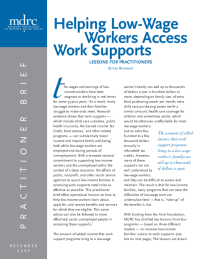Helping Low-Wage Workers Access Work Supports
Lessons for Practitioners
The wages and earnings of low-income workers have been stagnant or declining in real terms for some 35-plus years. As a result, many low-wage workers and their families struggle to make ends meet. Research evidence shows that work supports — which include child care subsidies, public health insurance, the Earned Income Tax Credit, food stamps, and other related programs — can substantially boost income and improve family well-being, both while low-wage workers are employed and during periods of unemployment.
The amount of added income that work support programs bring to a low-wage worker’s family can add up to thousands of dollars a year: a hundred dollars or more, depending on family size, of extra food purchasing power per month; extra child care purchasing power worth a similar amount; health care coverage for children and sometimes adults, which would be otherwise unaffordable for most low-wage workers; and an extra few hundred to a few thousand dollars annually in refundable tax credits. However, many of these supports are not well understood by low-wage workers, and they can be difficult to access and maintain. The result is that for low-income families, many programs that can ease the difficulties of low-wage work are undersubscribed — that is, “take-up” of the benefits is low.
With funding from the Ford Foundation, MDRC has distilled key lessons from four work support programs — the Supporting Work Project, an employer-based model; SingleStop USA and Earn Benefits, two programs based on a national nonprofit/local community organization model; and the Work Advancement and Support Center Demonstration, based on a public workforce system model. The lessons are based on the way these four programs address five basic challenges to increasing the take-up of work supports and helping customers to maintain work supports once received: (1) finding and connecting to low-wage workers, (2) making it easy for workers to participate, (3) maintaining work supports over time, (4) adopting a customer service approach, and (5) implementing appropriate management and staffing systems.
In many respects, the administration and rules governing the benefits that are now called “work supports” are just beginning to catch up with the fact that many people who receive them are employed and raising families. The lessons that are laid out in this practitioner brief from four innovative programs should help public, nonprofit, and other social service agencies increase low-wage workers’ access to these supports — ones that they may not realize they qualify for or that they believe are too complicated and inconvenient to pursue.






